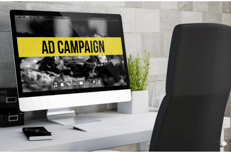Paid Advertising vs. Content Marketing: Which Delivers Sustainable Growth?
Wealth Picture Media Staff
3/7/20254 min read


Key Takeaways
How content marketing and paid advertising work together to drive sustainable growth.
When to prioritize content marketing over paid ads and vice versa.
How strategic content distribution enhances ad effectiveness and overall marketing ROI.
The Customer Journey: Ads vs. Content
What happens when someone sees an ad on LinkedIn, Facebook, or YouTube? Do they immediately make a purchase, or do they research the company first?
Most clients don’t buy immediately. Instead, they go down a research rabbit hole—checking your website, reading reviews, and comparing alternatives. This is why content marketing and paid advertising should work together, not as standalone strategies.
You're losing potential customers if you’re running paid ads without a solid content marketing foundation. But when should you prioritize paid ads versus content marketing, and how do they complement each other? Let’s break it down.
Content marketing involves creating and distributing valuable, relevant content to attract and retain a clearly defined audience. Common content formats include:
Blog posts
Videos
News articles
Infographics
Podcasts
Case studies
What Is Content Marketing?


Content Marketing helps search engines deliver information about your business to your ideal client.
The goal? To provide helpful information, establish credibility, and cultivate trust with your audience. This trust increases the likelihood that potential customers will choose your brand when they are ready to purchase.
Unlike paid ads, content marketing continues to generate organic traffic long after it’s published. It improves search engine rankings, strengthens your online presence, and builds authority in your industry—all while reducing dependence on costly advertising (HubSpot Blog Survey, 2024).
Content Distribution’s Role in Ad Effectiveness
Even the best-paid advertising campaigns can fall flat if potential customers can’t find supporting information that reinforces your brand’s credibility. Distribution plays a crucial role in ensuring that content reaches the right audience, at the right time, and in the right format (Dragon360 Podcast: Beyond Creation, 2024).
When an ad catches someone’s attention, they often search for more information before making a decision. If your brand lacks blog posts, videos, or case studies that validate the claims in your ad, you risk losing that potential customer.
A strategic content distribution approach across search engines, email newsletters, industry forums, and social media ensures your brand remains visible and authoritative. When potential clients encounter your messaging multiple times through high-quality, well-placed content, trust builds, increasing the likelihood of engagement and conversion.
Many-to-One Relationship
Repurposing content also extends its reach and impact. A single blog post can be transformed into a LinkedIn article, an email newsletter, a short video, or an infographic. This ensures that no matter where your audience interacts with your brand, they encounter a consistent message reinforcing your expertise.
AI-powered tools can further optimize content distribution by identifying the best-performing platforms and adjusting messaging based on audience behavior. This data-driven approach helps ensure that your content supports paid advertising efforts by providing the necessary trust signals to convert ad-driven visitors into customers.


Distribution to reputable sites is made easy with Wealth Picture Media services.
What Is Paid Advertising?
Paid ads, such as LinkedIn and Facebook Ads, provide instant visibility by promoting your brand across social media and search platforms. These ads allow precise targeting based on demographics, interests, and behaviors. You pay per click, impression, or conversion, making it a fast but often costly strategy.
According to LinkedIn statistics:
40% of B2B marketers say LinkedIn is their top revenue-generating platform (SocialSonic, 2024).
LinkedIn ads reach over 900 million professionals worldwide.
Sponsored LinkedIn posts have 2x higher conversion rates than other social media ads.
Facebook advertising remains powerful, but for B2B brands, LinkedIn often delivers higher-quality leads. However, relying solely on paid ads can be risky—costs fluctuate, algorithms change, and without content to support them, ads can fail to convert effectively (Backlinko, 2024).
Content Marketing vs. Paid Advertising: Key Differences
Allocating Your Marketing Budget
Determining the right balance between content marketing and paid advertising is essential for maximizing your return on investment. The right strategy depends on your business stage, goals, and available resources. Whether you're just starting out, testing your marketing efforts, or scaling up, a well-planned budget allocation can drive sustainable growth while optimizing spending.
If You’re Just Starting:
Focus 100% on content marketing to build authority and drive organic traffic.
If You Have Some Marketing Experience:
Split your budget 50% content marketing, 50% paid ads—using ads to test messaging and scale effective content.
If You’re Scaling:
Allocate 10-30% of your budget to content marketing to sustain organic growth, while optimizing paid ads for conversions.


If money is no object, go with paid ads.
Bottom Line: Content First, Ads Second
Content marketing isn't optional for professional service providers and B2B SaaS businesses—it’s essential. It builds the foundation for brand trust, organic traffic, and customer loyalty. Paid ads can accelerate growth, but without strong content, they often lead to wasted spend.
Be Seen. Be Trusted. Be Chosen.
Investing in content marketing is the best place to start if you’re looking for a sustainable way to increase your online visibility. Need help crafting a content distribution strategy that works? Explore our services at Wealth Picture Media and get started today.
Wealth Picture Media
Expert content marketing for professional service businesses.
Navigation
+1 510-210-3980
© 2025. All rights reserved. Content, including images, displayed on this website is protected by copyright laws. Downloading, republication, retransmission, or reproduction of content on this website is strictly prohibited. Terms of Use | Privacy Policy
530 Divisadero Street PMB 919, San Francisco, CA, 94117
